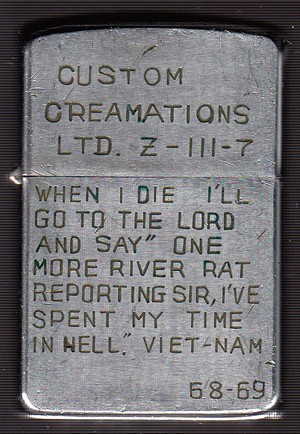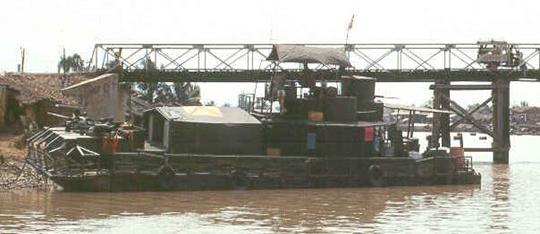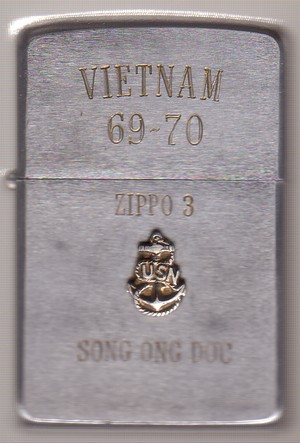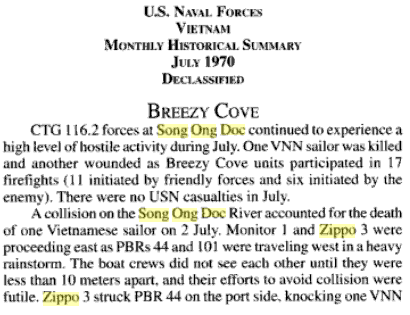Die auf dieser Seite gezeigten Zippo stammen aus meiner eigenen Sammlung
Zippo trifft Zippo
Begriffsbestimmungen - War Slang
Unter dem Begriff "Zippo" verstanden Soldaten sehr häufig nicht in erster Linie das verlässliche Benzinfeuerzeug, vielmehr wurde die Bezeichnung "Zippo" oftmals für Flammenwerfer verwendet. Es ist zu vermuten, dass die Firma Zippo nicht gerade begeistert war von dieser Tatsache.
Vietnam Order of Battle (Shelby L. Stanton)
Zippo: Flamethrower
Zippo mission: A search-and-destroy mission
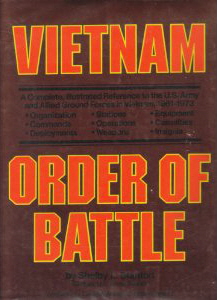
The Viet Nam Zippo 1933 – 1975 (Jim Fiorella)
Zippo: Flamethrower, from the cigarette lighter. U.S. Navy Monitor boat re-fitted with a long-range flamethrower to clear area bunkers and huts.
Zippo Job/ Zippo Mission/ Zippo Raid: Search and destroy mission in which villages are set on fire. The allusion is to Zippo cigarette lighters.
Zippo Squad: Squad that conducts a Zippo job.
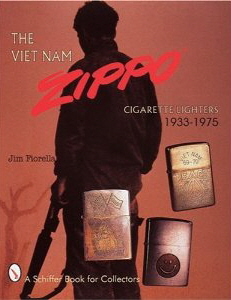
Vietnam Zippos – American Soldier’s Engravings and Stories 1965 – 1973 (Sherry Buchanan)
Zippo: Flame-thrower
Zippo Mission or Raid: Search-and-Destroy Mission
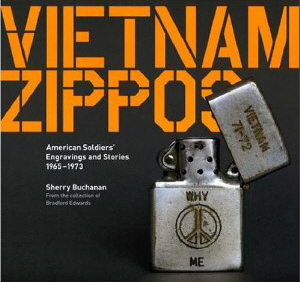
War Slang – American Fighting Words and Phrases Since the Civil War (Paul Dickson)
Zippo: A flamethrower; from the brand of cigarette lighters.
Zippo job/ Zippo mission/ Zippo raid: A search-and-destroy mission in which villages are set afire. The allusion is to Zippo cigarette lighters.
Zippo squad: A squad that conducts a Zippo Job.
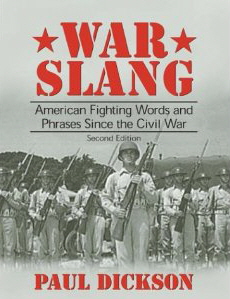
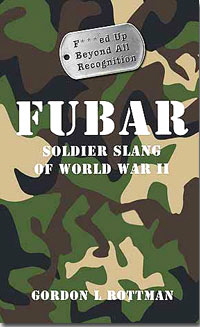
FUBAR – Soldier Slang of World War II (Gordon L Rottman)
Zippo: 1) Flamethrower, portable or tank-mounted, ‘blowtorch’.
Zippo: 2) M4 tank and its alarming propensity for catching fire when struck by a shell. The term Ronson was also used. Both Zippo and Ronson were popular cigarette lighter brands.
Waffensysteme
Während des Vietnam Krieges wurden primär zwei Systeme mit Flammenwerfern des Typs M10-8 ausgerüstet: Der Flammenwerfer M132 (Basisfahrzeug M113, rechts) sowie einige Boote der Mobile Riverine Force (Task Force 117, Teil der "Brown Water Navy", unten).
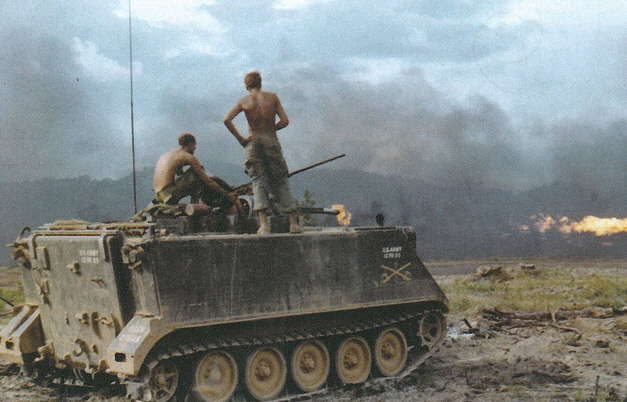
Flammenwerfer M132
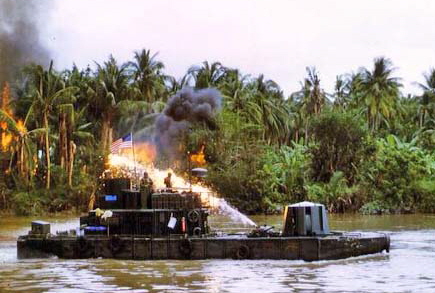
umgebauter Monitor mit Flammenwerfern (Quelle: oliv-drab.com)
Mengengerüst der Zippo Boote in Vietnam
4 Truppentransporter ATC(F) wurden mit M132 bestückt
2 Truppentransporter ATC(F) wurden zu Zippo Booten umgebaut
4 Program 4 MON(F) wurden zu Zippo Booten umgebaut
6 Program 5 MON(F) wurden neu als Zippo Boote gebaut
Abkürzungen
ATC: Armored Troop Carrier, nicknamed "Tango" or "Ragtop"
ATC(F): Armored Troop Carrier-Flamethrower, nicknamed "Zippo"
MON: Monitor, a heavily armed vessel that supported the assault craft and troops
MON(F): Monitor-Flamethrower, also nicknamed "Zippo"
Diese Boote trugen in der Bezeichnung ein “Z”. Wie nicht anders zu erwarten war, stand das "Z" für "Zippo".
|
|
|
Vietnam Zippo eines der beiden Truppentransporter (ATC), welche zu einem Zippo Boot umgebaut wurden (ATC(F): T-111-7 -> Z-111-7 (River Assault Squadron 11, River Assault Division 111): Initially, an ATC was used to test an Army M132A1 flamethrower armored personnel carrier (APC) to burn out enemy bunkers along the shoreline. This conversion was called the “Zippo” boat. Another ATC (T-111-7) was converted to permanently mount two M10-8 flamethrower turrets and the associated fuel and compressed air to run them. One Monitor, M-92-2 mounted two flame guns aft of the 40mm turret in where the mortar pit was located. Later, several Monitors were converted to Zippo boats by mounting the M10-8 flamethrower turrets on the bow and the napalm and compressed air cylinders in the space formerly occupied by the mortar pit. Still later, several Program 5 Monitors were converted to Zippo boats Below: Another Tango boat, T-111-7, was converted to mount two M10-8 flame guns on top of a modified bow. The fuel bladder for the liquid napalm and compressed air tanks were put under armor in the well dec. This is the ATC conversion to a Zippo boat after its turnover to the Vietnamese. The bar armor has been extended around the bow to protect the flame guns, the two are shown on the raised platform on the bow. The deckhouse behind the flame guns is for the boat crew. [Photo: Tom Lefavou]
Die folgenden Ausführungen von Mike Brady erklären die Gravuren des Zippo (“Custom Creamations”): Don, I'm a little "in my cups" at the moment but I just visited our web site and read about the first "zippo boats" in the Nam. I was a gunner aboard T-111-11, T-11-13 and lastly "Boat Captain ofA- 111-1. My boat crew and I got sent to Cambodia for my last month in-country. I got extended one more time for Operation "Giant Slingshot". However, some time before that mess I was a gunner aboard T-111-13 and had a hand in the retrofitting of T-111-7 as a "Zippo". I had the best tool box in the squadron. Do you remember the skill called "comshaw"? Well, I was good at it. The engineer on my boat knew how good I was at obtaining tools. It was an art form. Anyway, I helped the "EM's" install the stuff in the well deck for all that flame. I hated getting greasy but I was pretty good at what I did back then. Additionally, most folks don't know about the tape player that played a little tune called," I Am The Got Of Hell Fire" and they also gave out business cards that said," Custom Creamations By Racy Scalps Zippo Seven." Don, I live in Texas and most people here "Remember the Alamo", however; I remember "Ben Tre". Twice! I hurt because of those experiences. I'm 55 years old and I can't get those pictures out of my mind. I was a 20mm. gunner on the medevac boat on our first visit to Ben Tre and unfortunately I made a second trip down that river. Then I got the opportunity to go to Cambodia. Isn't that special? Don, I thank God for the MRFA and our Brothers.......May God be with all of us "old farts". Welcome Home Brother...... Gunner Brady A-111-1 |
|
|
|
Dieses sehr gut erhaltene Feuerzeug schliesst den Bogen vom ursprünglichen "Zippo" zum umgangssprachlich verwendeten "Zippo", einem Monitor Boot mit Flammenwerfern. Der folgende Auszug zeigt den geographischen Bezug der Gravuren deutlich auf:
Leider lässt sich heute nicht mehr zweifelsfrei eruieren, wer der ursprüngliche Besitzer dieses Feuerzeuges war. Es ist möglich, dass es Thomas Lee Fye war. |

